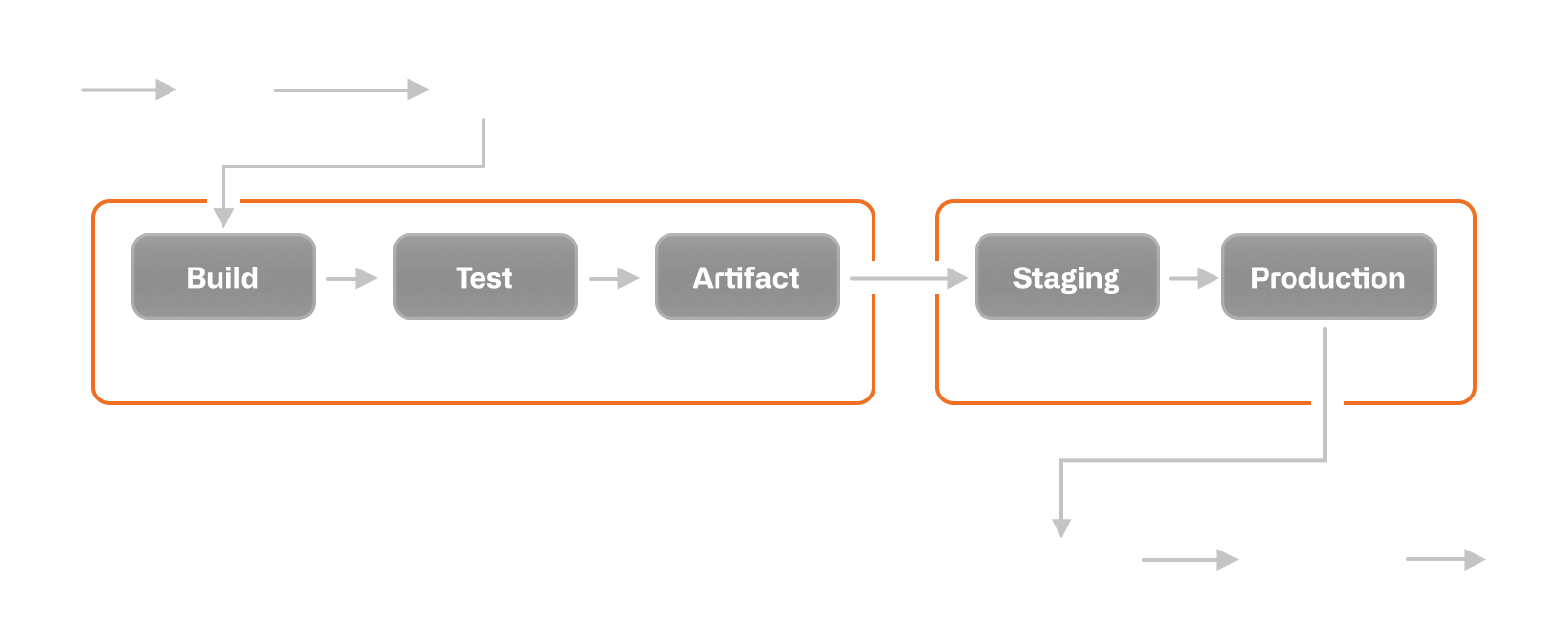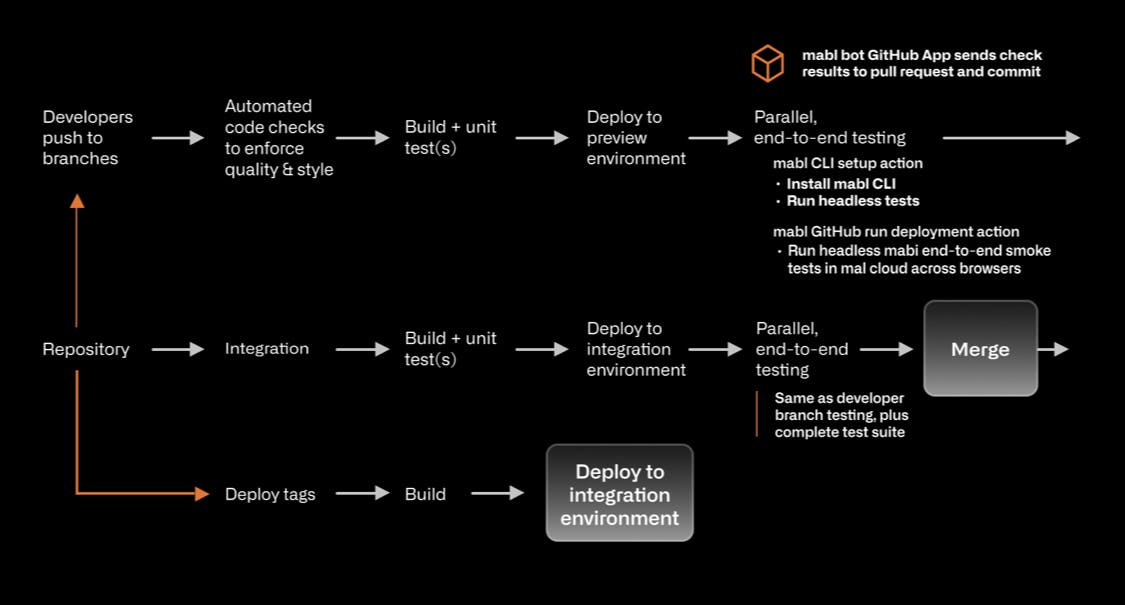CI/CD: The What, The Why, and The How
CI/CD — Continous Integration/Continuous Delivery&Deployment.
The What
CI/CD, or Continuous Integration/Continuous Deployment, is a set of automated processes that help developers rapidly and reliably build, test, and deploy code changes. These processes, which are often referred to as a "CI/CD pipeline," and are essential for achieving DevOps success because they enable teams to quickly and efficiently deliver code updates to customers.
Basically,
Here's an example of how it works:
A developer writes some code and commits it to a shared repository (like a folder on a computer).
The CI/CD system automatically detects the new code and starts a process called a "build." This checks the code for errors and prepares it for testing.
The CI/CD system runs automated tests to make sure the new code is working as intended.
If the tests pass, the CI/CD system automatically deploys the new code to a staging or production environment (like a website or app).
The new code is now available for users to see and use.

credits - @ resources.github.com
Continous Delivery and Continous Deployment
There are two main types of CI/CD pipelines: continuous delivery and continuous deployment. In a CI/CD pipeline that uses continuous delivery, code changes are automatically built, tested, and delivered to production-ready environments, but a human still needs to manually sign off on the final release.

credits - @ resources.github.com
When someone says CI/CD, the “CD” they’re referring to is usually continuous delivery, not continuous deployment. What’s the difference? In a CI/CD pipeline that uses continuous delivery, automation pauses when developers push to production. A human—your operations, security, or compliance team—still needs to manually sign off before final release, adding more delays. On the other hand, continuous deployment automates the entire release process. Code changes are deployed to customers as soon as they pass all the required tests.
CI and DevOps automation - Continous Integration and Developer Operations
Continuous deployment is the ultimate example of DevOps automation. That doesn’t mean it’s the only way to do CI/CD, or the “right” way. Since continuous deployment relies on rigorous testing tools and a mature testing culture, most software teams start with continuous delivery and integrate more automated testing over time”
Why CI/CD?
The short answer: Speed!
Learn more about the benefits of CI/CD from GitHub resources
Development speed
CI/CD provides ongoing feedback to developers, allowing them to make smaller code changes more frequently rather than waiting for a single, large release.
Stability and reliability
Through automated, continuous testing, CI/CD helps maintain code stability and ensures that codebases are always ready for release.
Business growth
By automating manual tasks through CI/CD, organizations can allocate resources towards innovation, customer satisfaction, and reducing technical debt, allowing engineers to focus on more high-impact work.
The How:
Building your CI/CD toolkit
If you're looking to set up a CI/CD pipeline for your organization, here are some steps to get started:
Choose a version control system:
A version control system (VCS) is a tool that tracks changes to code over time. This is essential for CI/CD, as it allows you to manage and revert code changes if needed. Popular options include Git, Mercurial, and Subversion.
Set up a build server:
A build server is a machine that runs automated build and test processes. This can be a physical server or a virtual machine hosted in the cloud. There are many build servers available, including Jenkins, CircleCI, and TeamCity.
Select a testing framework:
Testing is an important part of the CI/CD process, as it helps ensure that code changes are working as intended. There are many testing frameworks to choose from, including JUnit, TestNG, and Mocha.
Choose a deployment tool:
A deployment tool is used to automate the process of deploying code changes to production environments. Options include Ansible, Chef, and Puppet.
Consider using a continuous integration server:
A continuous integration (CI) server can help automate the process of building and testing code changes. Popular options include Jenkins and TeamCity.
Release:
Depending on the specific CI/CD workflow, the code may be automatically released to users at this point (in the case of continuous deployment) or it may be made available for manual review and release (in the case of continuous delivery).
Monitoring:
The CI/CD system should monitor the performance of the code in production and alert developers if there are any issues.
Feedback:
The CI/CD system should provide feedback to developers on the success or failure of builds, tests, and deployments. This allows developers to quickly identify and fix any issues that may arise.
Ci/CD best practices
Once you have these tools in place, you can start building your CI/CD pipeline. Here are some best practices to follow:
Use version control for all code changes: This allows you to track changes and revert them if necessary.
Set up automated builds and tests: This helps ensure that code changes are working as intended and reduces the risk of errors.
Deploy code changes automatically: This can significantly speed up the deployment process and reduce the risk of errors.
Monitor your pipeline: It's important to monitor the performance of your CI/CD pipeline and identify any issues or bottlenecks.
What does a CI/CD workflow look like?
An example of a CI/CD workflow in action might look like this:

credits - @ resources.github.com
A developer writes some code and commits it to the shared repository.
The CI/CD system detects the new code and starts a build.
The build process compiles the code and runs automated tests.
If the tests pass, the code is deployed to a staging environment.
The code is made available for manual review and release by a team member.
If the code is approved, it is automatically deployed to the production environment.
The CI/CD system monitors the performance of the code in production and alerts the team if there are any issues.
What makes a successful CI/CD
Continuous Integration/Continuous Delivery (CI/CD) is a software development practice that aims to improve the speed and reliability of code updates by automating the build, test, and deployment process. While CI/CD can bring many benefits to an organization, it is not a panacea and requires careful planning and execution to be successful.
Here are some key factors that contribute to the success of a CI/CD implementation:
Adequate infrastructure:
CI/CD requires a robust and scalable infrastructure to support the build, test, and deployment process. This may include build servers, testing environments, and production servers.
Well-defined processes:
It's important to have clear and well-defined processes in place for how code changes are committed, built, tested, and deployed. This helps ensure that the CI/CD pipeline runs smoothly and reduces the risk of errors.
Automated testing:
Automated testing is an essential part of CI/CD, as it helps ensure that code changes are working as intended. It's important to have a comprehensive testing strategy in place, including unit tests, integration tests, and other types of tests.
Continuous integration:
Continuous integration (CI) is the practice of automatically building and testing code changes as they are committed to the repository. This helps identify and fix issues early in the development process and ensures that code changes are always ready for deployment.
Collaboration and communication:
CI/CD requires close collaboration and communication among team members. It's important to have a clear understanding of roles and responsibilities, as well as clear communication channels to facilitate the flow of information.
Tooling:
The right tools can make a huge difference in the success of a CI/CD implementation. It's important to choose tools that fit the needs of the organization and are well-suited to the development process.
Culture:
A culture that values collaboration, continuous improvement, and automation is essential for the success of CI/CD. It's important to foster a culture that encourages experimentation and continuous learning.
By addressing these factors, organizations can set the stage for a successful CI/CD implementation and realize the many benefits that this practice has to offer.
What can you do with CI/CD?
Here are a few examples of how companies have implemented CI/CD in their software development process:
Netflix has adopted a microservices architecture and uses CI/CD to deploy thousands of code changes per day. They use a variety of tools, including Jenkins, Spinnaker, and AWS CodePipeline, to automate the build, test, and deployment process. You can read more about their approach here: infoq.com/articles/cicd-microservices-netflix
Spotify has a culture that values continuous delivery and has adopted a number of practices to support this, including CI/CD. They use tools like Jenkins, Artifactory, and Ansible to automate the build, test, and deployment process. You can read more about their approach here: infoq.com/presentations/spotify-continuous-..
Salesforce has adopted a microservices architecture and uses CI/CD to deploy code changes quickly and reliably. They use a variety of tools, including Jenkins, GitLab, and Docker, to automate the build, test, and deployment process. You can read more about their approach here: infoq.com/presentations/salesforce-microser..
Workday is a cloud-based software company that relies on CI/CD to deliver updates to its customers quickly and reliably. They use tools like Jenkins, Git, and Ansible to automate the build, test, and deployment process. You can read more about their approach here: infoq.com/presentations/workday-cicd
Zscaler is a cybersecurity company that uses CI/CD to deploy code changes to its cloud-based platform quickly and reliably. They use tools like Jenkins, GitLab, and Terraform to automate the build, test, and deployment process. You can read more about their approach here: infoq.com/presentations/zscaler-cicd
Bolt simplified its development process with GitHub Enterprise, embraced automation with GitHub Actions, and streamlined CI/CD and package management through GitHub Packages.
You can read more about their approach here https://github.com/customer-stories/bolt
These are just a few examples of how new fortune companies are using CI/CD to improve the speed and reliability of their software development process.
There are many other examples out there, and each company may have a slightly different approach depending on their specific needs and goals.
Conclusion
It's worth noting that while CI/CD can bring many benefits to an organization, it is not a one-size-fits-all solution and requires careful planning and execution to be successful.
